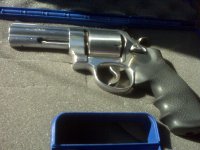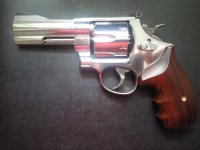I own a 610-3 10mm revolver with the 4" barrel, unfluted cylinder, and has the lock.
I recently purchased this gun at a local gun show in my small town and I love it. It's very accurate and powerful, and I like I can also shoot 40S&W ammo to save a little money vs the cost of 10mm. I've taken it out to the farm shooting several times and it quickly has replaced my Ruger GP100's as my favorite revolver.
Here is my question: A friend told me that this is a rare gun. I have no idea. Any truth to this?
I've attached a picture.
I recently purchased this gun at a local gun show in my small town and I love it. It's very accurate and powerful, and I like I can also shoot 40S&W ammo to save a little money vs the cost of 10mm. I've taken it out to the farm shooting several times and it quickly has replaced my Ruger GP100's as my favorite revolver.
Here is my question: A friend told me that this is a rare gun. I have no idea. Any truth to this?
I've attached a picture.




